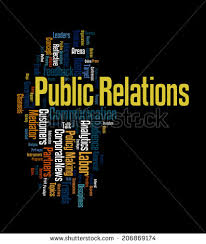Public relations is the deliberate,
planned and sustained effort to establish and maintain mutual understanding and
excellent communications. This post identifies and explains the core concepts and practices of public
relations. The core concepts of public relations are: planning, sustained
communication, mutual understanding and stakeholder analysis. The core practices are centered on building
relationships. The skills involved are: written, oral and listening skills,
management skills; and ethical thinking.
Also explained in this report are the differences between public
relations and marketing and how they converge and support each other through
relationship marketing and integrated marketing communication.
Planning.
Planning is a key function and skill of the
public relations practitioner. They say
that being well organized is a key attribute to a successful practitioner). One tool will a company to
stay organized and communicate their intentions with their stakeholders is the
public relations plan.
There are four benefits for an organization
if they develop a public relations plan.
These advantages are: planning provides an opportunity to gain an
assessment of the situation, it helps establish objectives; and there is more
control over the public relations program and the desired image to be
projected. The fourth benefit of
planning is that it allows spending to be within the budget.
Here is an example followed by
Dove when they developed a communication plan for launching a new campaign is:
a situation analysis, objectives, strategies, target audiences and target media. The situation
analysis provides a back ground into the new brand and its strengths and
weaknesses. The setting of objectives
creates an awareness of what is to be achieved.
Strategies define how the objectives are to be achieved. The communications effort is directed toward
the target audiences. Target media are
the communication channel for reaching the target audience.
Sustained
Communication.
Sustained communication is any activity that is involved in the
communication with the stakeholders involved with the organization or brand. Public relations practitioners earn attention
by creating awareness and communication through multiple channels. Sustained communication involves communicating
regularly with stakeholders with a long term perspective. Therefore, sustained
communication builds long term relationships through creating a positive
understanding by communicating regularly with stakeholders.
Public relations’ should be approached from a long term
perspective. It takes time to build a
brand and earn respect. An effective
public relations campaign has a solid base of sustained communication added to
it. What is required from the public
relations practitioner is the production and distribution of content that is
both relevant and interesting. An
organization needs to open diologue and share ideas with both the internal and
external stakeholders.
Sustained, long term communication will create strong
relationships with stakeholders that will have a number of benefits for a
company. Communicating with stakeholders strengthens their position when an
attempt is to be made at influencing them.
Also, sustained communication with stakeholders can make them sympathize
with the needs of the brand. Moreover,
communicating with shareholders can ensure funds are accessible.
For
example, hamburger chain McDonald's is practicing sustained communication with
their consumers through social media. McDonald's have a Facebook page advertised to teenagers and other site
members. The hamburger giant promotes
their meal deals and environmental and sport sponsorship information to their
target audience. Young people are
spending more time on the internet than traditional channels like television
and print. Consumers can interact with
the corporation through private messaging.
Mutual
Understanding.
Mutual understanding occurs when the organization and their target
public recognize and appreciate each others goals, needs and wants.
Mutual understanding does not mean mutual agreement. Public relations
practitioners should recognize the need for mutual understanding between the
organization and its stakeholders during communication.
For
example, James Grunig’s four models of
public relations provides a summary of how public relations has evolved from
one-way models of communication into two-way symmetrical interaction with
stakeholders. The
modern two-way symmetrical communication model has evolved from dictating
information to stakeholders to influencing them and creating mutual
understanding between the organization and its stakeholders. Therefore, mutual understanding should be
promoted and can only be achieved with two-way communication.
The
presence of mutual understanding has many advantages an organizations internal
and external communication. By developing a mutual understanding they can foster
trusting relationships and define objectives to provide mutual benefits for the
organization and its stakeholders. Organizational and stakeholder satisfaction
can be positively affected if both parties understand each other. Therefore, trust, mutual respect and
mindfulness are all positive components of mutual understanding.
For
example Kiwisaver provider AMP provides regular reporting to their fund
investors through quarterly disclosure statements delivered by email. This provides easier access to investors to
information about their Kiwisaver funds.
Investors can call the customer services team with their questions and
concerns.
Stakeholder
Analysis.
Stakeholders are a group of people on whom
an organization depends for its success and who have an interest (stake) in the
organization. Stakeholders
both have an effect and are affected by an organization. Every organization has both internal and
external stakeholders.
Internal
stakeholders are groups within the organization. For example: the owners, the managers,
shareholders and workers. The external
stakeholders are groups outside the organization. For example:
shareholders, the community and consumers. Because these stakeholders all have different
interests and priorities it would be advantageous for an organization to conduct
a stakeholder analysis.
For
example, whenever soft drinks manufacturer Oasis Industries conducts a
stakeholder analysis they include both the internal and external
environments. When analyzing the
internal environment the organization’s performance and anything that may
hinder success should is considered. Insofar
as the analysis of the external environment Oasis Industries consumer base, competitors, and other social,
economic and political factors are
considered for their impact on the organization.

No comments:
Post a Comment